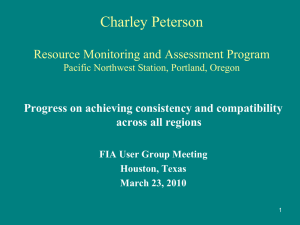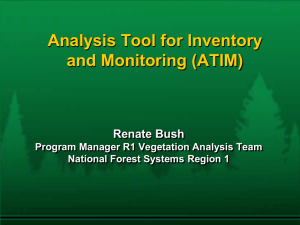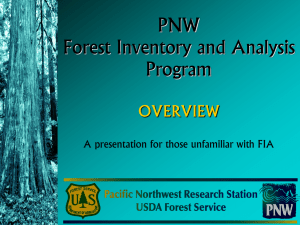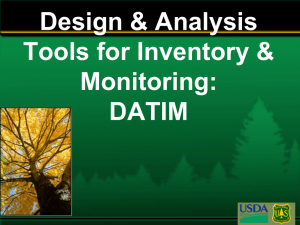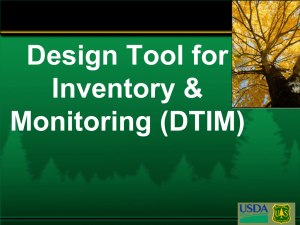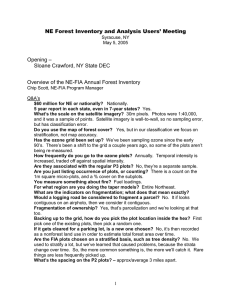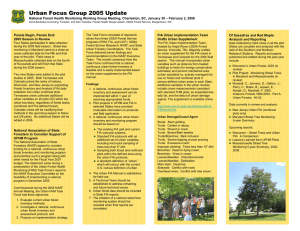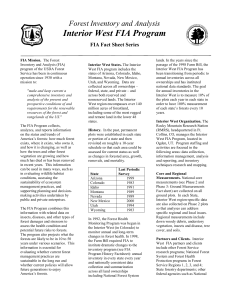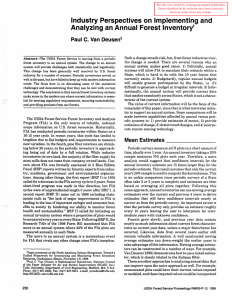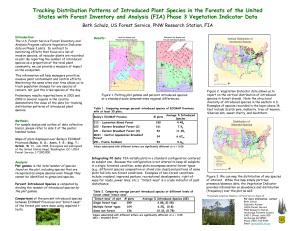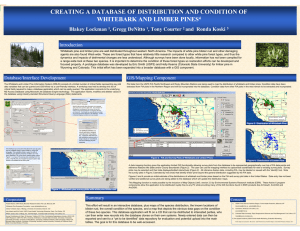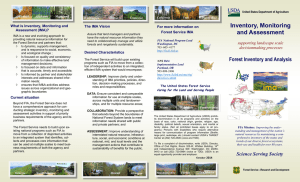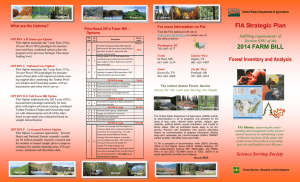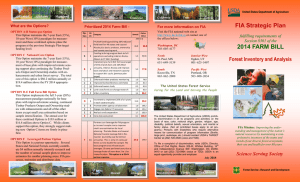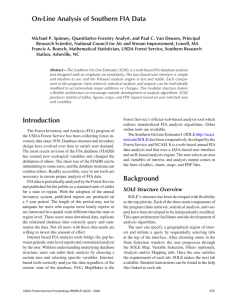Basic Functional Requirements of the Design Tool for Inventory and Monitoring
advertisement
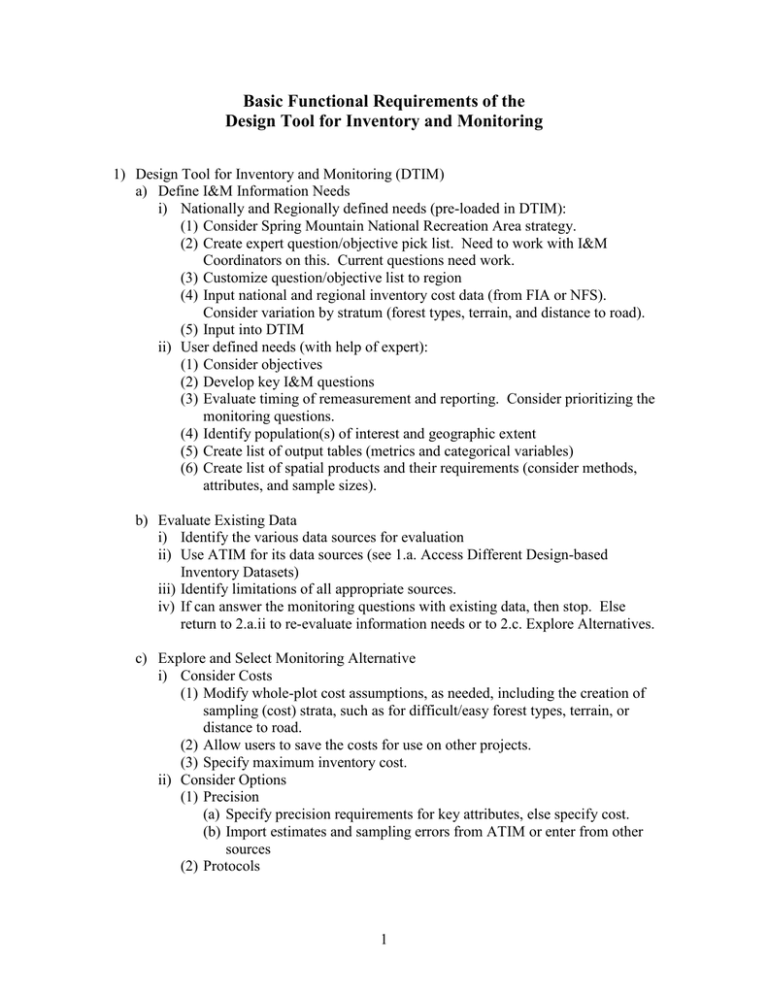
Basic Functional Requirements of the Design Tool for Inventory and Monitoring 1) Design Tool for Inventory and Monitoring (DTIM) a) Define I&M Information Needs i) Nationally and Regionally defined needs (pre-loaded in DTIM): (1) Consider Spring Mountain National Recreation Area strategy. (2) Create expert question/objective pick list. Need to work with I&M Coordinators on this. Current questions need work. (3) Customize question/objective list to region (4) Input national and regional inventory cost data (from FIA or NFS). Consider variation by stratum (forest types, terrain, and distance to road). (5) Input into DTIM ii) User defined needs (with help of expert): (1) Consider objectives (2) Develop key I&M questions (3) Evaluate timing of remeasurement and reporting. Consider prioritizing the monitoring questions. (4) Identify population(s) of interest and geographic extent (5) Create list of output tables (metrics and categorical variables) (6) Create list of spatial products and their requirements (consider methods, attributes, and sample sizes). b) Evaluate Existing Data i) Identify the various data sources for evaluation ii) Use ATIM for its data sources (see 1.a. Access Different Design-based Inventory Datasets) iii) Identify limitations of all appropriate sources. iv) If can answer the monitoring questions with existing data, then stop. Else return to 2.a.ii to re-evaluate information needs or to 2.c. Explore Alternatives. c) Explore and Select Monitoring Alternative i) Consider Costs (1) Modify whole-plot cost assumptions, as needed, including the creation of sampling (cost) strata, such as for difficult/easy forest types, terrain, or distance to road. (2) Allow users to save the costs for use on other projects. (3) Specify maximum inventory cost. ii) Consider Options (1) Precision (a) Specify precision requirements for key attributes, else specify cost. (b) Import estimates and sampling errors from ATIM or enter from other sources (2) Protocols 1 (a) Consider creating and applying national and regional sets of NFS minimum data standards. Provide warnings/errors for deviations from these standards, assuming ATIM will be used. (b) Automatically select indicator suites based on attributes selected. Provide warnings/errors for selecting parts of suites or dropping Core attributes, assuming ATIM will be used. (c) Temporary or permanent. This affects what kind of change estimates can be made (net change only if temporary) and the precision of them. (d) Allow FSVeg protocols from CSE to be used as long as the data can be used in ATIM (see data standards in 1.a.). Note: consider PDR software issues (Exam software or MIDAS). Currently having turn around time problems with FIA. (e) Note: dropping standard FIA attributes may affect the ability to use FIA’s data collection software and to use in FIADB and for Forest and State reporting. (3) Sampling Design (a) Simple Random Sampling (spatially balanced) – with or without intensification of an existing sample. Default. Assumes that user can use post-stratification. (b) Stratification for special areas or other map-based domains. Note: may affect the ability to use in FIADB and for Forest and State reporting. Also can affect probabilities of selection if strata change over time. (4) Plot Design. Note: changing the plot design affects the ability to use in FIADB, and for Forest and State reporting. (a) 1-4 subplots (other than 4 results in non-standard data). Could limit this in regional rules. Allowing plot size and distances to change is not desired. 4 subplots is the default. (b) Modify default values for crew times and costs based on FIA region, NFS Region, or Forest. (c) Consider co-located plots for other resource attributes, e.g., MSIM. (5) Logistics – efficient use of a crew’s day and travel time. (6) Consider data management capabilities (to make design process generic and to motivate folks to plan ahead) for those folks who don’t plan on using the rest of the toolkit. Have them enter costs to use or modifying existing software vs. developing new system. Rule of thumb is that processing is 25% of budget and analysis is another 25%, so field costs are 50%. iii) Select Inventory (1) Use sample sizes and plot costs to compute total survey cost for various options (2) Output plot design, sampling design, and sample size descriptions. Is this into the Protocol Sample Design (later?) (3) Select Sample Locations (a) Polygon (target population) 2 (b) Select option for choosing plots (simple random, fixed grid, spatial filling curves, etc.). (c) Optionally reject plots too close to one another? (d) Optionally use existing plots/grids? (e) Output Plot List with unique (not in FIADB or FSVeg) plot identification and GIS locations (also new or existing). Also output FSVeg setting identification. This team needs to specify which setting information to use. (f) Create and maintain GIS coverage of locations and associated metadata to characterize them, including any relationships to other samples. d) Provide Guidance for an I&M Implementation Plan i) Provide instructions on developing the Field Guide (1) Provide link to the current regional FIA manual and an NRIS example (2) List the changes to the Guide (add/drops) ii) Provide instructions on developing Training Materials (1) Provide link to the current regional FIA training materials (2) List the changes to the training materials (add/drops) iii) Determine Software Needs (1) Protocol Sample Design? (2) Migrate and prepare any prior plot data (3) Data Recorder – MIDAS? (keep flexible to handle changes for now) (4) Auditing/Editing software (5) Data loading – identify any changes needed to the standard loader. (6) Compilation Tool iv) Determine Equipment Needs v) Populate Work Plan vi) Develop Contract, as appropriate (give examples) 3
